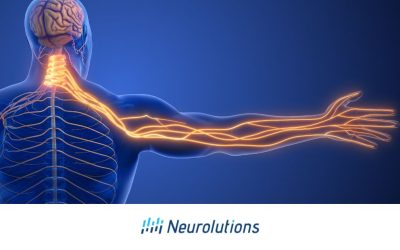After a stroke, many survivors experience paralysis or weakness on one side of their body, making everyday tasks like walking, dressing and even standing challenging (1).
To assess and track a patient’s progress in regaining these abilities, healthcare professionals often rely on the Fugl-Meyer Assessment (FMA). The FMA is a widely validated and standardized tool used in both clinical and research settings to evaluate motor recovery in stroke rehabilitation
The Fugl-Meyer Assessment (FMA), developed in the 1970s, is a widely used tool to evaluate motor function, balance, and other physical abilities in stroke survivors, both early in recovery and throughout rehabilitation (2). While it can be used in a clinical setting, its primary function is to be used for research purposes. It helps healthcare providers understand the severity of conditions that often occur with stroke, such as hemiplegia or hemiparesis.
What is the Fugl-Meyer Assessment?
The Fugl-Meyer Assessment is an evaluation tool used to measure motor function, balance, and other physical abilities in stroke survivors to track recovery progress.
Overview:
The Fugl-Meyer Assessment (FMA) is a standardized assessment for stroke survivors who have weakness or paralysis on one side of their body.
Developed in 1975 by Dr. Axel Fugl-Meyer and his team, the FMA is based on the stages of recovery outlined by Dr. Signe Brunnstrom (3). This test evaluates five key areas of physical function (4):
- Motor function. Assesses abilities such as walking and performing purposeful movements.
- Sensory function. Evaluates the ability to perceive sensations, such as pressure or touch, in the hands or feet.
- Balance.
- Range of motion of joints. Measures the ability to maintain a steady posture without tipping or falling.
- Joint pain. Identifies pain that may restrict movement in areas such as the hip or elbow.
The Assessment Process:
The Fugl-Meyer Assessment (FMA) is a standardized tool that may be used in stroke rehabilitation to evaluate motor function and related abilities. When utilized, it can help establish a baseline for movement impairments and guide treatment planning. The FMA can also be administered at various points during occupational and/or physical therapy (OT and/or PT) to monitor progress and recovery over time. It is typically conducted by a therapist with expertise in stroke rehabilitation
The FMA utilizes a straightforward scoring system for each item on , ranging from 0 to 2 (4):
0 – No function
1 – Partial function
2 – Full function
The Fugl-Meyer Assessment (FMA) has a maximum total score of 226, divided into key categories such as motor function, sensory function, balance, range of motion, and joint pain. Conducting the FMA typically requires basic tools, including a tennis ball, a small spherical object, a reflex hammer, and a distraction-free space with enough room for movement. While the full assessment takes approximately 35 minutes to complete (5), it can be administered in less time if broken into subset tests. These subtests, known as the Upper Extremity Fugl-Meyer (UEFM) and Lower Extremity Fugl-Meyer (LEFM), focus on specific regions of the body to provide targeted insights into a patient’s recovery progress. The UEFM will usually take up to 20-30 minutes.
Interpreting Fugl-Meyer Assessment (FMA) Scores:
The Fugl-Meyer Assessment (FMA) provides a structured way to evaluate motor recovery after a stroke. The maximum score is 226, but motor function—the most commonly used portion—has a max score of 100 (66 for the upper extremity, 34 for the lower extremity). Higher scores indicate better motor function, while lower scores reflect significant impairments.
General Score Interpretation:
- 0-50: Severe impairment
- 51-84: Moderate impairment
- 85-99: Mild impairment
- 100+: Minimal to no impairment
Example of Recovery Progression
Consider a stroke survivor, Alex, who begins rehabilitation with an initial upper extremity FMA (UEFM) score of 20 out of 66 possible points, indicating severe motor impairment. At this stage, Alex struggles with basic arm movements and gripping objects. After three months of targeted therapy, Alex’s score improves to 45/66, reflecting partial recovery and moderate motor impairment—now able to lift their arm and grasp lightweight objects. With continued rehabilitation, Alex reaches a score of 60/66 at six months, demonstrating improved dexterity and functional independence in daily activities like dressing and eating. Alex now presents with a mild motor impairment according to the UEFM.
This example highlights the FMA’s value in tracking progress, identifying areas for intervention, and setting realistic rehabilitation goals for stroke survivors.
Upper Extremity Fugl-Meyer (UEFM) vs Lower Extremity Fugl-Meyer (LEFM)
The UEFM assesses movement and coordination in the arms, while the LEFM focuses on motor function in the legs.
The Upper Extremity Fugl-Meyer (UEFM) and Lower Extremity Fugl-Meyer (LEFM)
assessments are both part of the FMA used to evaluate a stroke survivor’s motor function, but they focus on different areas of the body.
UEFM focuses on the shoulder, elbow, wrist, and fingers, assessing a person’s ability to move these parts of the arm. It also evaluates reflexes, passive range of motion (PROM), upper extremity pain, and sensation (6). Similarly, the LEFM primarily assesses function at the hip, knee, ankle, and toes. It assesses how well a person can move their lower body and function.
Synergies, Coordination, and Speed:
The Fugl-Meyer Assessment evaluates how well muscles work together, the smoothness of movements, and the speed of coordinated actions.
Both the UEFM and LEFM assess how well muscle groups work together, known as synergies, to produce smooth, coordinated movements (7). After a stroke, these synergies can become disrupted. For example, movements such as touching a finger to the nose may be harder to perform since the muscles in the arm no longer work together as they once did.
Coordination and speed of movement are also evaluated during the FMA. For instance, a stroke survivor may be asked to touch their finger to their nose or point their toes and the test will assess how smoothly and quickly they can do so.
While synergy refers to how muscle groups should normally work together during movement, spasticity is a different condition. Spasticity happens when muscles tighten up too much because the elastic parts of the body have lost their ability to move. This can make the muscles move on their own without control. Although spasticity is not specifically assessed by the Fugl-Meyer, it can have a significant impact on synergy and the ability to perform coordinated movements.
To measure spasticity directly, a different scale is typically used, such as the Ashworth Scale. This scale assesses muscle tone and tightness (8).
Components of the Fugl-Meyer Assessment
The Fugl-Meyer Assessment evaluates motor function, sensory function, balance, joint range of motion, and joint pain to understand a stroke survivor’s physical recovery.
1. Motor Function:
A stroke survivor’s motor function significantly impacts their ability to perform everyday tasks such as brushing their teeth, walking up and down the stairs, or getting out of bed. The FMA assesses how well the arms, legs and joints are able to move and coordinate during these activities.
For the UEFM, the motor functions that are tested evaluates movement and coordination of the arm, including:
- Elevation: Moving a body part upward, such as shrugging the shoulder, which involves coordinated muscle action to lift the joint.
- Retraction/Depression: Moving a body part downward, like lowering the shoulder after a shrug, which requires muscles working together to return the joint to its resting position.
- Abduction: Moving a limb away from the body, for example, raising the arm to the side by engaging the shoulder joint.
- Adduction: Bringing a limb back toward the body, such as returning an outstretched arm to the side.
- Shoulder movements: Lifting the arm forward (flexion), sideways (abduction), and rotating the arm.
- Elbow and forearm movements: Bending and straightening the elbow, forearm pronation (palm down) and supination (palm up).
- Wrist control: Flexing, extending, and stabilizing the wrist while performing tasks.
- Hand and finger function: Gripping, pinching, and releasing objects like a cup or small ball.
- Coordination tasks: Moving the hand to touch the mouth or placing it on the back of the head.
Similarly, the LEFM assessment focuses on evaluating movements of the hip, knee, and ankle to assess lower limb function.
2. Sensory Function
For stroke survivors, being able to feel and control movements is essential for everyday tasks like eating and walking. For example, when using a spoon to self feed, a person needs to feel the spoon in their hand. Similarly, walking requires feeling the ground beneath the feet and coordinating the muscles and joints that allow someone to walk.
After a stroke, many survivors experience hemiplegia, which often causes sensory impairments on one side of the body. This means they might have trouble feeling pressure, heat, cold, or pain on the affected side.
These sensory issues can make simple activities challenging. For example, without being able to feel the ground with one foot, it is difficult to know that it is placed properly on the ground, increasing the risk of tripping or falling. In the FMA, the ability to sense and respond to touch, pressure, or pain in the arms and legs is tested to help determine how sensory loss may impact daily activities.
3. Balance
Balance is a key part of moving safely and independently. Balance is often impaired after a stroke, especially if the stroke causes weakness or paralysis on one side of the body. The FMA includes seven categories to assess the stroke survivor’s ability to balance in both sitting and standing positions (9). If a stroke survivor cannot maintain balance while sitting, they may slump to one side, making it difficult to engage in other daily activities. Likewise, if a person struggles to keep their balance while standing or walking, the risk of falling increases. This is a particular concern during OT and/or PT, where maintaining balance is crucial for learning to walk again and for fall prevention.
4. Joint Range of Motion
Joint range of motion refers to how far a joint can move in all of its natural directions. This range of motion is an important part of a person’s ability to perform daily activities like eating, walking and dressing. Each joint in the body has a unique way it can move, depending on its type.
After a stroke, many survivors experience a loss of joint mobility, especially in the arms and legs. This means that joints may no longer be able to move through their full range of motion, making simple tasks much more difficult to perform.
5. Joint Pain
Joint pain is a common issue for stroke survivors, especially when moving an affected limb. It often results from prolonged immobility or paralysis, leading to muscle stiffness and tightening around the joint. According to the American Stroke Association, shoulder pain is one of the most common types of chronic pain experienced by stroke survivors (10).
For stroke survivors, joint pain can create additional barriers to recovery. Painful joints can make it harder to fully participate in rehabilitation and daily activities slowing progress in recovering lost motor skills. For example, walking with a painful hip, knee, or ankle joint can be discouraging, and it may reduce a person’s motivation to improve their walking ability.
Benefits of the Fugl-Meyer Assessment
The FMA offers several key benefits for clinicians and patients, helping to guide recovery and improve rehabilitation outcomes. Here are some of the main advantages of using the FMA:
- Comprehensive Evaluation: The FMA assesses multiple domains of motor function, including motor control, sensory function, balance, joint range of motion, and joint pain. This broad scope provides a well-rounded picture of a patient’s functional abilities.
- Evidence-Based: It is widely regarded as a reliable and valid tool for assessing motor recovery in patients with neurological conditions. Its results can be used to guide therapeutic interventions and track progress over time.
- Personalized treatment plans: The FMA helps identify specific areas where a stroke survivor may be struggling, such as weakness, limited range of motion, or difficulty with certain movements. This allows for development of individualized treatment plans tailored to the patient’s specific recovery needs.
- Goal Setting and Progress Monitoring: The detailed assessment helps clinicians set specific rehabilitation goals based on the patient’s baseline performance. By regularly using the FMA, clinicians can track changes in motor function and adjust the treatment plan as necessary.
- Understanding the recovery process: The FMA offers insight into the recovery process, helping clinicians understand why a stroke survivor may be struggling with certain tasks like walking or self feeding. Many factors, such as motor skill impairment or pain, can influence recovery, and the FMA helps pinpoint these factors so that therapists can adjust their approach accordingly.
- Boosting motivation and support: For stroke survivors, seeing objective progress can be highly motivating. The FMA provides tangible evidence of recovery which can encourage a person to stay committed to the rehabilitation process.
- Predictive Value: It can serve as a predictor of long-term recovery potential, helping clinicians and patients understand the likelihood of functional independence post-injury.
Frequently Asked Questions (FAQs)
1. How often is the FMA completed?
The frequency of the FMA depends upon the individual stroke survivor’s progress in therapy. If a person is showing rapid improvement in therapy, the FMA could be administered more frequently to assess the progress and adjust the treatment plan to promote further recovery. If progress is slower than expected, the FMA may be administered less frequently. Whichever occurs, the FMA should be administered at regular intervals to accurately assess whether progress is being made in regaining lost motor skills and to guide adjustments to the rehabilitation plan.
2. Is the Fugl-Meyer Assessment (FMA) painful?
No, the FMA is not painful if administered properly. The therapist administering the FMA will ensure the patient is comfortable throughout the process. If any pain or discomfort is expressed at any point during the testing of muscle or joint movements, the therapist will immediately stop. The focus of the test is to measure function, not to push through pain. If pain is present, the therapist will score the movement based on what can be done without causing injury.
3. Can the FMA predict full recovery?
While the FMA is a valuable tool for tracking progress and providing insight into a stroke survivor’s recovery, it cannot predict full recovery. Stroke recovery is a highly individualized process that varies widely from person to person. Most stroke survivors experience the most significant improvements within the first three months after the stroke, but recovery can continue for many months or even years (11). Several factors influence the recovery journey, including the location and severity of the brain injury, the individual’s overall health, age, and participation in rehabilitation. Additionally, cognitive factors such as memory and concentration, as well as emotional and social support, can play a crucial role in the recovery process. While the FMA is an effective measure of motor skill progress, it should not be seen as a definitive predictor of whether full recovery will be achieved.
4. What training is needed to administer the FMA?
Administering FMA requires training to ensure accuracy and consistency. Healthcare professionals, such as physical and occupational therapists, should be familiar with the assessment’s purpose, scoring system, and standardized administration techniques. Training typically includes proper patient positioning, movement guidance, and hands-on skills to assess reflexes, range of motion, and muscle tone. Accurate scoring and interpretation are essential to track progress and guide treatment. Practical experience, mentorship, or formal courses can help clinicians develop proficiency and maintain reliability in administering the FMA.
5. What are some limitations of the FMA?
While the FMA is a valuable tool for evaluating motor recovery after a stroke, it has some limitations. Its simple three-point scoring system may not capture small but meaningful improvements in function, such as slight gains in wrist movement that could impact daily activities. Additionally, the sensory function and joint pain components rely on self-reported data, which can vary and may not always provide an accurate measure (12). Finally, the FMA is just one of several assessment tools available, and therapists may use additional methods to gain a more comprehensive understanding of a stroke survivor’s recovery.
6. Can the FMA be used in populations outside of stroke?
The Fugl-Meyer Assessment (FMA) has primarily been validated for use in stroke populations, particularly those with hemiplegia, where it is widely regarded as a reliable and valid measure of motor recovery. However, its use in other populations, such as individuals with spinal cord injuries, traumatic brain injuries, or movement disorders, is less well-established. Some studies have explored its application in these populations, but additional research is needed to confirm its validity and reliability across diverse neurological conditions. For now, its primary validation remains in stroke rehabilitation, where it has the most robust evidence base (13, 14, 15).
Conclusion
The Fugl-Meyer Assessment (FMA) is a tool used by therapists to evaluate and track motor function and recovery in stroke survivors, enabling personalized treatment plans to enhance independence in daily tasks.
The Fugl-Meyer Assessment (FMA) is a valuable tool used by therapists to assess the motor skill and functional capabilities of stroke survivors, particularly those with hemiplegia. It helps clinicians track progress during rehabilitation and adjust treatment plans based on the individual’s recovery. By regularly administering the FMA, therapists can tailor therapy to align with the specific needs of the stroke survivor, focusing on the areas that impact their daily life. This personalized approach supports the goal of regaining as much independence as possible in every day tasks.
For more information, visit the Shirley Ryan AbilityLab’s Rehabilitation Measures Database for detailed information on the FMA’s purpose, application and scoring system.
References:
- Cleveland Clinic (Cleveland, OH). Hemiplegia. Webpage: https://my.clevelandclinic.org/health/symptoms/23542-hemiplegia
- Dunning K. (2011). Fugl-Meyer Assessment of Sensorimotor Impairment. In: Kreutzer JS, et al. (Editors). Encyclopedia of Clinical Neuropsychology. Springer: New York, NY. Webpage: https://link.springer.com/referenceworkentry/10.1007/978-0-387-79948-3_1806#citeas
- University of Gothenburg, Institute of Neuroscience and Physiology [Gothenburg, Sweden]. Fugl-Meyer Assessment. Webpage: https://www.gu.se/en/neuroscience-physiology/fugl-meyer-assessment#:~:text=This%20scale%20was%20first%20proposed%20by%20Axel%20Fugl-Meyer,widely%20used%20for%20clinical%20assessment%20of%20motor%20function.
- Canadian Partnership for Stroke Recovery. Fugl-Meyer Assessment of Sensorimotor Recovery After Stroke (FMA). Webpage: https://strokengine.ca/en/assessments/fugl-meyer-assessment-of-sensorimotor-recovery-after-stroke-fma/
- Canadian Partnership for Stroke Recovery. Fugl-Meyer Assessment of Sensorimotor Recovery After Stroke (FMA). Webpage: https://strokengine.ca/en/assessments/fugl-meyer-assessment-of-sensorimotor-recovery-after-stroke-fma/
- Barth J, Geed S, Mitchell A, et al. (2020). Characterizing upper extremity motor behavior in the first week after stroke. PLoS One 15(8): e0221668. Webpage: https://journals.plos.org/plosone/article?id=10.1371/journal.pone.0221668
- Koh K, Oppizzi G, Kehs G, et al.(2023). Abnormal coordination of upper extremity during target reaching in persons post stroke. Scientific Reports13: 12838. Webpage: Koh, K., Oppizzi, G., Kehs, G. et al. Abnormal coordination of upper extremity during target reaching in persons post stroke. Sci Rep 13, 12838 (2023). https://www.nature.com/articles/s41598-023-39684-4
- Harb A, and Kishner S. (Last update: May 1, 2023). Modified Ashworth Scale. In: StatPearls [Internet]. StatPearls Publishing: Treasure Island, FL. Webpage: https://www.ncbi.nlm.nih.gov/books/NBK554572/
- Kiefer Parreiras de Menezes KK, Scianni AA, Avelino PR, et al. (2023). Balance deficit is the domain of the Fugl-Meyer scale that best explain limitations in functional independence during hospitalization after a stroke. Journal of Stroke and Cerebrovascular Diseases (32)12: 107386. Webpage: https://www.sciencedirect.com/science/article/abs/pii/S1052305723004093
- American Stroke Association. Coping with Pain. Webpage: https://www.stroke.org/en/about-stroke/effects-of-stroke/physical-effects/managing-pain/coping-with-pain
- Grefkes C, and Fink GR. (2020). Recovery from stroke: Current concepts and future perspectives. Neurological Research and Practice 16:2: 17. Webpage: https://www.ncbi.nlm.nih.gov/pmc/articles/PMC7650109/
- Lin J-H, Hseuh I-P, Sheu C-F, et al. (2004). Psychometric properties of the sensory scale of the Fugl-Meyer Assessment in stroke patients. Clinical Rehabilitation 18(4): 391-397. Webpage: https://journals.sagepub.com/doi/10.1191/0269215504cr737oa
- Sivan M, Mead G, van Wijck F, et al. The Fugl-Meyer Assessment of Motor Recovery after Stroke: A Review of its Practical Application in the United Kingdom. J Neurol Phys Ther. 2011;35(3):129-137. doi:10.1097/NPT.0b013e31822a4e5f.
- Baque E, Darsaud A, Drunat S, et al. Validity and Reliability of the Fugl-Meyer Assessment of Motor Recovery After Stroke: A Systematic Review. Stroke. 2017;48(9):2515-2518. doi:10.1161/STROKEAHA.117.017789.
- Husain M, Rees G, Sala E, et al. Use of Fugl-Meyer assessment in stroke recovery. J Neurol Phys Ther. 2016;28(1):17-23.





